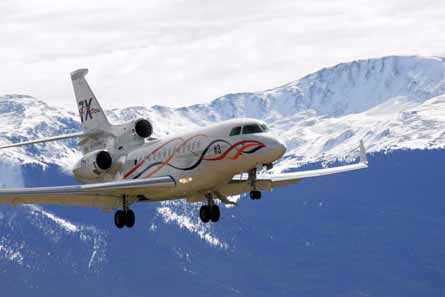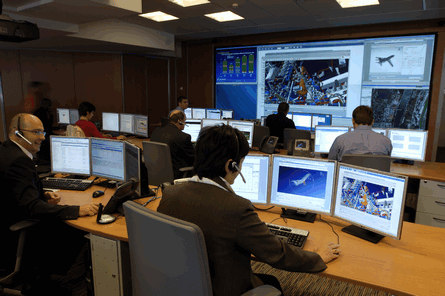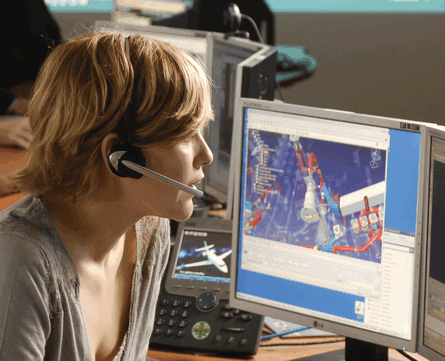Dassault’s new St Cloud Technical Centre is a huge step forward for the French manufacturer’s customer service offering. Liz Moscrop reports.
A visit to the Dassault Falcon Technical Centre in St Cloud, Paris, is like stepping into a science fiction movie. The operational heart of the organism is a bank of huge LCD screens, pumping information to a group of watching experts. On display is real time global graphical and text data, such as where there are aircraft on the ground.
The system can also bring up a digital image of an actual aircraft, relaying exactly where there is a technical issue to the on-site experts. Customer service engineers (CSEs) are privy to instant information and able to solve, or start solving the problem immediately.
 |
|---|
© Dassault |
The centre came about as part of Dassault’s drive to improve its customer service offering. The OEM has had a technical centre in place in Teterboro for the last 12 years, but the advanced St Cloud facility, along with a further resource in Boise, Idaho enables the company to offer true 24/7, 365-days-a-year support. On average, the Falcon technical help desk and spares account representatives receive 2,000 calls a month. To answer them, the manufacturer has hired 422 employees, 200 of whom are in St Cloud and 222 in Teterboro and Boise.
Teterboro is open 7am-4pm; Paris 7.30am-6pm; Boise 4pm-12am, all local time, so there is full round-the-clock coverage. European customers call Paris, and at the end of the day calls are automatically routed to the US and vice-versa. There are also duty customer service managers throughout the world, who speak the same language as their customers.
Jacques Chauvet, senior vice president, worldwide customer service, has implemented new training initiatives for front line customer contact and sees the St Cloud centre as a leap forward for the French manufacturer. He says: “This enables us to provide rapid and personal support to all Falcon operators in the long term, as well as effecting a smooth entry into service for the 7X.” By the end of 2008 Dassault aims to have St Cloud fully operational, staffed by ten customer service engineers, who are knowledgeable on all Falcon models. Chauvet adds: “By putting more experts on the phones, we free up managers and field reps to assist operators.” The OEM says its goal is for the technical centres to provide solutions and answers during the first call.
 |
|---|
© Dassault |
A team of 25 ATA specialists dedicated to different aspects of the aircraft are co-located alongside the engineers. These ATA specialists can provide in-depth troubleshooting support. They have individual areas of deep knowledge on specific systems, such as the landing gear.
The cabin is important to passengers, so there is an ATA specialist whose remit includes the coffee maker. Chauvet says: “The idea is when there is an AOG situation to immediately provide a short term solution to return the aircraft into service as soon as possible.”
The physical proximity of the ATA specialists to the CSEs at the centres, plus powerful information tools form a large part of Dassault’s drive for efficiency. The CSEs have access to each individual aircraft’s history during a call, so that critical information, such as the maintenance manual, wiring diagrams, and aircraft and engine logbooks are at their fingertips.
Dassault has 1,710 aircraft in service, flown by 1,015 Falcon operators in 62 countries. By 2012 the company anticipates that there will be 2,250 aircraft based in Europe alone, including the first examples of its groundbreaking 7X model, on show for the first time at Farnborough.
Today 30% of the airframer’s new customers have no prior knowledge of operating a business aircraft and consequently have no infrastructure in place. St Cloud provides much-needed support and service when they acquire their aircraft. Chauvet explains: “In the past operators have had good knowledge and have owned aircraft before. Now 20-30% need support since they use aircraft like they use a car.” An increasing number of aircraft are flying 600-700 hours per year, sometimes more than 1,000 hours per year.
 |
|---|
© Dassault |
Guillaume Landrivon is Dassault’s director of customer relations and field service. He says: “Fifty percent of the calls we receive are not highly technical and do not need experts. We make sure that information is readily available on our portal or in information we publish.” Typical requests are for a copy of a service bulletin or the number for the Honeywell hotline. The remaining 50% are troubleshooting requests, for forms such as a non technical objection (NTO), necessary to ferry a stricken aircraft to a service centre for repair, for example after a bird strike.
Every Monday there is an internal meeting “to put each customer inside the company”. This comprises several departments including: production, design, and purchasing. The review assesses “customer mood”. Each customer is banded green, amber or red. An amber or a red code warrants immediate attention and there is one person dedicated as front person to ensure the problem is solved. There is a further review meeting every Friday afternoon between the US and Europe.
Dassault is also finalising a system whereby a dedicated laptop comes with each new aircraft delivered. This enables the customer to download information directly from its EASy cockpit to the technical centre, and for a videoconference to take place, sharing information with engineers in St Cloud and Dassault’s various facilities. The laptop beams information directly to the factory in Bordeaux. The aircraft technician has access to the blueprint of the aircraft in the CATIA model, and the downloaded aircraft data tells him what he needs to do to make a repair. He can control the aircraft through the centralised maintenance computer.
Dassault is making huge strides to match the pulse of its customers. In response to client requests by the end of 2007 the OEM had invested $522 million in its parts inventory. It now boasts a parts availability of 97.3% measured by its ability to deliver at the time the customer asked for it. The objective is 98%. When fully staffed by the end of this year, the St Cloud and Boise centres will provide a 250% increase in manpower dedicated to technical support from the 2006 level. Chauvet says: “In the past our staff were mainly engineering people, who were technically rather than customer oriented. Now customer service is seen as a vital part of our offering.”
Source: Flight Daily News
















